Can bearded dragons eat cilantro? It’s a common question among reptile owners looking to add variety and fresh herbs to their pet’s diet. Known for its bold aroma and bright flavor, cilantro is often found in human meals—but is it safe for your beardie?
In this article, we’ll explore the answer to “can bearded dragons eat cilantro” by examining its nutritional value, potential health risks, and how to prepare and serve it properly. Whether you’re a first-time beardie parent or an experienced reptile keeper, understanding the role of herbs like cilantro in your dragon’s diet is key to keeping them healthy, balanced, and happy.
Can Bearded Dragons Eat Cilantro Safely?
Cilantro may seem like a harmless herb, but when it comes to bearded dragons, even safe greens require a closer look. This section explains how cilantro fits into a reptile’s diet and what precautions to consider.
Is Cilantro Safe or Harmful for Bearded Dragons?
Is Cilantro Safe or Harmful for Bearded Dragons?
Cilantro is generally safe for bearded dragons when offered in moderation. It contains helpful nutrients such as vitamins A, C, and K, along with antioxidants and a small amount of calcium. These nutrients support your dragon’s immune function, hydration, and digestion.
However, cilantro’s calcium-to-phosphorus ratio is not ideal for regular feeding. It also contains oxalates, which can block calcium absorption over time. This makes it unsuitable as a daily food.
The good news? If served occasionally and balanced with calcium-rich greens, small amounts of cilantro are safe for healthy adult bearded dragons. Treat it as a supplement, not a staple, and it can enhance your beardie’s meals without causing nutritional harm.
Cilantro vs. Other Herbs in a Bearded Dragon’s Diet
Cilantro is just one of several herbs that can be fed to bearded dragons. So how does it compare to options like parsley, basil, and mint?
This herb stands out for its moderate levels of vitamins A, C, and K. Its distinct aroma can attract even picky eaters. But, like parsley and basil, it contains oxalates.
Parsley is high in Vitamin K, but its oxalate levels are even greater than cilantro’s, so it requires stricter limits. Basil offers some anti-inflammatory benefits and a pleasant aroma but should still be rotated in small quantities.
Mint can aid digestion and is safe in very tiny amounts. However, some dragons dislike its strong taste.
All things considered, cilantro is among the better herb options—but it must be rotated with calcium-rich, low-oxalate greens to maintain dietary balance.
Just like cilantro, spinach is another leafy green often debated among reptile owners. Learn more in our full guide on Can Bearded Dragons Have Spinach Safely?
Can Bearded Dragons Eat Cilantro Regularly?
While cilantro is safe for bearded dragons in small amounts, you should not offer it regularly or in large portions. This herb lacks the calcium levels needed to support strong bone health, and it contains oxalates, which can block calcium absorption over time. You should only use cilantro as a supplemental food, not a core part of your dragon’s diet.
The ideal frequency for feeding cilantro is once or twice per week, and it should always be offered in small portions. A few finely chopped leaves mixed into a salad is more than enough. Avoid making it the main green in any meal.
To maintain variety and nutritional balance, rotate cilantro with other safe greens like collard greens, mustard greens, and dandelion leaves. These staples provide the calcium and fiber your bearded dragon needs on a regular basis.
When used in rotation and combined with high-calcium foods, cilantro can be a healthy and enjoyable treat. Just remember—moderation is key to preventing long-term health issues.
Nutritional Benefits of Cilantro for Bearded Dragons
Cilantro may not be a staple green, but it does offer some valuable nutrients when fed occasionally and in proper portions. From vitamins to antioxidants, this herb can provide health benefits that support your bearded dragon’s immune system, hydration, and digestion. Let’s take a closer look at what makes cilantro a useful supplemental food.
Key Nutrients in Cilantro (Vitamins A, C, and K)
Cilantro delivers essential vitamins that support your bearded dragon’s health when you feed it in moderation. Vitamin A helps maintain clear vision, supports proper growth, and strengthens the immune system. However, if you already give your dragon supplements, you need to monitor their Vitamin A intake to avoid overconsumption.
Vitamin C also plays a helpful role. While bearded dragons can produce some on their own, small dietary amounts can ease stress, support healing, and reduce inflammation.
Cilantro provides Vitamin K as well, which helps with blood clotting and bone strength. Even though dragons don’t need large quantities of this vitamin, it still adds valuable diversity to their diet.
Together, these nutrients make cilantro a smart, occasional addition to your beardie’s salad. For balance, always pair it with calcium-rich greens.
Hydration and Fiber Content for Digestion
Cilantro has a high water content, which can help provide a small hydration boost to your bearded dragon, especially in dry climates or during the warmer months. While it’s not a replacement for a clean water source, offering moisture-rich foods like cilantro can support overall hydration—especially for dragons that don’t drink often from bowls.
In addition to water, cilantro contains dietary fiber, which is important for maintaining a healthy digestive system. Fiber encourages smoother bowel movements and supports gut motility. This is particularly useful for dragons recovering from brumation or those prone to mild constipation.
However, the fiber content in cilantro is not as high as what you’ll find in staple greens. That’s why it should be used as a complementary herb rather than a primary vegetable. When mixed with more fibrous foods like collard greens or squash, cilantro can help round out your dragon’s diet with added hydration and gentle digestive support.
Antioxidants and Natural Detox Support
Cilantro contains natural antioxidants such as flavonoids and polyphenols, which help protect your bearded dragon’s cells from oxidative stress. These compounds neutralize harmful free radicals that may otherwise damage cells and trigger inflammation.
Though your dragon doesn’t need large amounts of antioxidants, small servings from foods like cilantro can offer mild anti-inflammatory benefits. These benefits become especially helpful during stressful events like shedding, relocation, or sudden temperature changes.
Many people use cilantro for its detoxifying properties, particularly its ability to bind to heavy metals and support liver health. While research on reptiles remains limited, occasional servings of antioxidant-rich herbs may contribute to long-term wellness.
As with any supplemental food, you should serve cilantro in moderation and pair it with calcium-dense, low-oxalate greens. Used correctly, it becomes a safe and nutritious part of your dragon’s plant-based menu.
For a deeper look into how to build a healthy, balanced feeding routine, check out The Complete Bearded Dragon Diet Plan
If you want a quick summary of cilantro’s nutritional value for bearded dragons, here’s a helpful breakdown of its key components per 100g:
| Nutrient | Amount per 100g |
| Calcium | 67 mg |
| Phosphorus | 48 mg |
| Vitamin A | 6748 IU |
| Vitamin C | 27 mg |
| Water Content | 92% |
| Oxalates | Moderate |
Health Risks of Feeding Cilantro Too Often
While cilantro can offer some nutritional benefits, feeding it too frequently can pose risks to your bearded dragon’s long-term health. Certain compounds in cilantro may interfere with nutrient absorption and lead to imbalances if not carefully managed. In this section, we’ll break down the key concerns and explain how to avoid common mistakes.
Low Calcium and Phosphorus Imbalance
One of the main problems with frequent cilantro feeding is its poor calcium-to-phosphorus ratio. Bearded dragons need calcium-rich foods with low phosphorus to develop strong bones and avoid metabolic disorders. Cilantro contains more phosphorus than calcium, which throws off this crucial balance if overused.
High phosphorus levels make it harder for your dragon’s body to absorb and use calcium. Over time, this can result in calcium deficiency. If you don’t supplement their diet properly, your bearded dragon may develop Metabolic Bone Disease (MBD)—a painful condition that weakens bones and affects mobility.
To protect your pet’s health, treat cilantro as an occasional herb. Always balance it with calcium-dense vegetables like collard greens, mustard greens, or turnip greens. Maintaining the right mineral ratio is essential for skeletal strength and long-term vitality.
Oxalates in Cilantro and Calcium Absorption
Cilantro, like many leafy herbs, contains oxalates—compounds that interfere with calcium absorption. When consumed in excess, oxalates bind to calcium in the digestive tract, forming insoluble crystals. This binding process prevents calcium from entering the bloodstream. For bearded dragons, which rely heavily on dietary calcium, this poses a serious concern.
A high-oxalate diet can eventually lead to calcium deficiency, even when paired with supplements or calcium-rich vegetables. That’s why cilantro and other oxalate-heavy herbs should only appear occasionally in your bearded dragon’s bowl—not daily.
To support proper calcium uptake, combine cilantro with low-oxalate, calcium-rich vegetables like dandelion greens, collards, or squash. This combination minimizes risk and helps your dragon absorb essential minerals more effectively.
Risk of Overfeeding Fresh Herbs
Herbs like cilantro add flavor and mild nutrition, but they lack the essential minerals your bearded dragon needs. Feeding too many herbs can crowd out more nutrient-dense staples.
Overfeeding cilantro may cause digestive issues, reduce mineral absorption, and increase the risk of calcium deficiency—especially if not balanced with rotation and variety. Relying on herbs alone limits exposure to the fiber and calcium found in key greens.
To prevent imbalance, offer fresh herbs like cilantro only once or twice a week. Rotate them with reliable staples like collard greens, squash, and mustard greens.
Balance and moderation are critical. By limiting cilantro and mixing it with high-quality vegetables, you’ll help your beardie stay healthy, hydrated, and nutritionally sound.
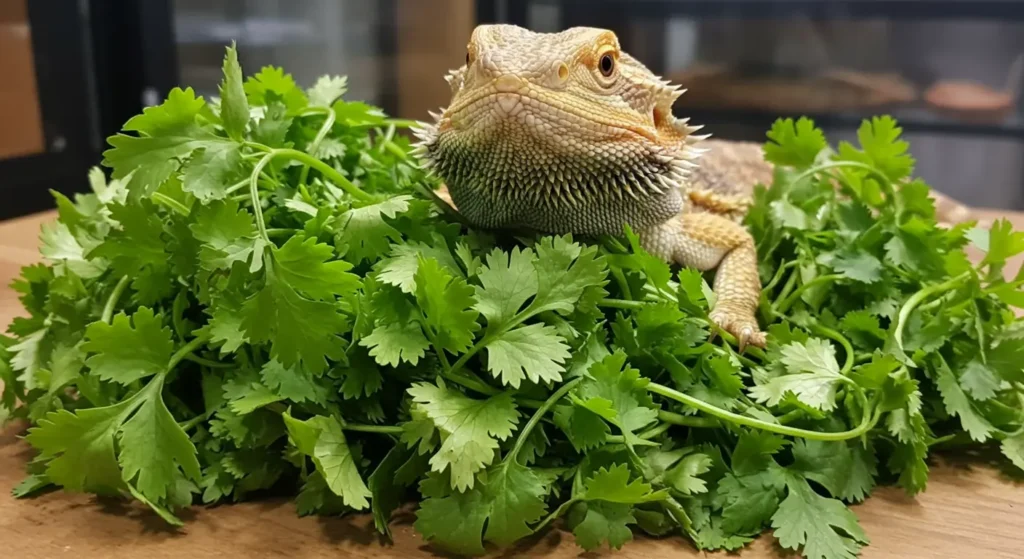
How to Serve Cilantro to Your Bearded Dragon
Feeding cilantro the right way is just as important as knowing whether it’s safe. Proper preparation and portion control ensure your bearded dragon gets the benefits without the risks. In this section, we’ll walk through how to serve cilantro correctly—from cleaning to mixing it with other safe foods.
Washing and Preparing Cilantro Properly
Before feeding cilantro to your bearded dragon, it’s important to clean and prepare it correctly. Always choose fresh, organic cilantro when possible, as it’s less likely to contain pesticides or chemical residues. Even if you buy organic, washing is still essential to remove dirt, bacteria, or leftover sprays.
Rinse the cilantro thoroughly under cool, running water. Gently rub the leaves and stems with your fingers to dislodge any debris. After rinsing, shake off the excess water and pat the herb dry with a clean towel or paper towel.
Next, remove the thick lower stems, as they can be tough and less digestible for bearded dragons. The leafy tops are softer and easier to chew. Chop the leaves into small, bite-sized pieces to reduce the risk of choking—especially for juveniles.
Serving clean, properly prepared cilantro ensures your dragon gets the most out of the herb without added health risks. Good preparation habits also reduce the chance of digestive upset or contamination from harmful residues.
Should You Chop or Leave Whole Leaves?
When it comes to serving cilantro, chopping the leaves is usually the safer choice, especially for younger or smaller bearded dragons. Whole leaves may be too large or stringy, making them harder to chew and increasing the risk of choking—particularly in baby or juvenile beardies.
For adult bearded dragons, small whole leaves may be manageable, but chopping is still recommended. Finely chopped cilantro blends more easily with other greens, encouraging even picky eaters to consume a balanced bite. This also helps distribute the flavor more evenly across the meal.
The ideal serving size for adults is a small pinch—roughly one to two teaspoons—mixed with other vegetables. For juveniles, reduce the portion by half and make sure the pieces are cut into even smaller bits.
By chopping cilantro into small, manageable pieces, you make it easier and safer for your bearded dragon to eat. It also helps ensure they don’t fill up on herbs alone, which lack the calcium and fiber found in staple greens.
Mixing Cilantro with Staple Greens and Veggies
Cilantro should never be the main ingredient in your bearded dragon’s salad. Instead, it works best as a complementary herb, paired with more nutritionally complete vegetables. This helps balance its low calcium content and ensures your beardie receives the right nutrients for bone health and digestion.
Collard greens, mustard greens, and dandelion greens are excellent base choices. These leafy greens are rich in calcium and fiber, making them ideal staples. Add a small amount of finely chopped cilantro to these greens for added variety and flavor. The strong aroma of cilantro can also help encourage picky eaters to try new foods.
For added texture and nutrition, you can include small portions of safe vegetables like butternut squash, acorn squash, or zucchini. These veggies provide hydration, beta-carotene, and fiber.
By rotating these greens and veggies with occasional herbs like cilantro, you’ll create a diverse, balanced diet that supports your bearded dragon’s overall health without the risk of nutritional gaps.
For added texture and nutrition, you can include small portions of safe vegetables like butternut squash, acorn squash, or zucchini. If you’re looking to add a tasty insect treat alongside greens, wax worms can be a great occasional protein source—but be sure to use them in moderation due to their high fat content.
When and How Often Can Bearded Dragons Eat Cilantro?
Even safe foods can become risky when fed too often—and cilantro is no exception. Understanding how frequently to offer it and in what amounts is key to avoiding nutritional imbalances. In this section, we’ll look at ideal serving sizes, feeding schedules, and how to monitor your dragon’s response.
Ideal Portion Sizes by Age and Size
The right portion of cilantro for your bearded dragon depends on its age and overall size. Adult beardies can handle small amounts of cilantro more easily because their digestive systems are fully developed. A portion for an adult should be around 1 to 2 teaspoons of finely chopped leaves, mixed with staple greens. This should only be offered once or twice per week.
Juvenile bearded dragons, on the other hand, have more delicate nutritional needs. They require higher levels of calcium and protein for growth. Because cilantro is low in calcium and contains oxalates, it should be offered to young dragons even more sparingly—about half a teaspoon at most, no more than once per week.
Avoid using cilantro as a main salad base, regardless of your dragon’s age. It should always be treated as a supplemental herb, not a primary food. Following these portion guidelines helps prevent nutritional imbalances and keeps your dragon healthy at every stage of life.
Weekly Feeding Schedule Examples
To keep your bearded dragon healthy, it’s important to follow a varied weekly feeding schedule that includes cilantro only in small amounts. A good rule of thumb is to offer cilantro once or twice per week, never on consecutive days. This helps reduce the risk of calcium interference while still providing the flavor and nutritional boost cilantro can offer.
For example, you might serve cilantro on Monday and again on Friday, mixed with calcium-rich greens like collard or mustard greens. On other days, rotate in different herbs or safe vegetables such as basil, squash, or dandelion greens.
If you’re feeding a juvenile dragon, offer cilantro just once per week and in smaller quantities. Younger dragons need more protein and calcium, so the focus should stay on live insects and calcium-dense greens.
Creating a balanced weekly plan that includes a mix of staple foods and occasional herbs ensures your dragon gets a wide range of nutrients without overexposure to oxalates or low-calcium vegetables.
Monitoring Reactions and Digestive Health
After introducing cilantro into your bearded dragon’s diet, it’s important to observe their behavior and digestion closely. While many beardies tolerate small amounts of cilantro well, each reptile is unique. Some may respond differently based on age, sensitivity, or overall diet quality.
Keep an eye on your dragon’s stool consistency. Loose or watery droppings may indicate that the cilantro is too hydrating or not well tolerated. You should also watch for changes in appetite, hydration levels, or energy. A healthy bearded dragon remains alert, active, and maintains regular eating habits.
If you notice any unusual behavior—like lethargy, bloating, or food refusal—it may be best to pause cilantro for a few weeks and consult a reptile vet if symptoms persist.
Occasional use of cilantro is generally safe, but consistent monitoring helps ensure it doesn’t lead to digestive upset or interfere with nutrient absorption. Keeping track of reactions allows you to make informed decisions about future herb rotations.
Frequently Asked Questions (FAQs)
1. Can bearded dragons eat cilantro every day?
No, bearded dragons should not eat cilantro every day. While it’s safe in small amounts, cilantro contains oxalates and has a poor calcium-to-phosphorus ratio. Offering it too frequently can interfere with calcium absorption and may increase the risk of metabolic bone disease over time.
2. Is cilantro safe for baby bearded dragons?
Cilantro is safe for baby bearded dragons in very small amounts. However, it should be offered sparingly—no more than once per week—and always chopped finely. Juveniles need more calcium and protein, so the focus should remain on nutrient-dense greens and live feeders.
3. Should I use cilantro stems or just the leaves
Only the leaves of cilantro should be used. The stems are tougher, harder to digest, and may pose a slight choking risk—especially for smaller or younger dragons. Always wash the herb thoroughly and chop the leaves into small pieces before serving.
4. What are signs that cilantro doesn’t agree with my bearded dragon?
Watch for signs such as loose stool, lethargy, reduced appetite, or bloating. These may indicate that your dragon isn’t tolerating cilantro well or that it’s being fed too frequently. If symptoms persist, remove cilantro from the diet and consult a reptile veterinarian.
5. Can cilantro be mixed with other vegetables for bearded dragons?
Yes! Cilantro pairs well with calcium-rich vegetables like collard greens, dandelion greens, mustard greens, and squash. Mixing it with staple veggies adds variety and flavor, but it should never make up the bulk of the salad.
Conclusion: Can Bearded Dragons Eat Cilantro?
So, can bearded dragons eat cilantro? Yes—when served properly and in moderation, cilantro can be a safe and nutritious addition to your beardie’s diet. This flavorful herb brings vitamins, antioxidants, hydration, and variety to their meals, making it a great occasional mix-in alongside staple greens.
That said, its oxalate content and poor calcium-to-phosphorus ratio make it unsuitable as a daily vegetable. Overuse can interfere with calcium absorption and increase the risk of long-term health problems.
To keep your bearded dragon healthy, offer cilantro in small, chopped portions just once or twice per week. Pair it with calcium-rich greens, observe your pet’s response, and adjust accordingly.
In the end, can bearded dragons eat cilantro? Absolutely—as long as it’s used sparingly, wisely, and as part of a well-balanced, varied diet.

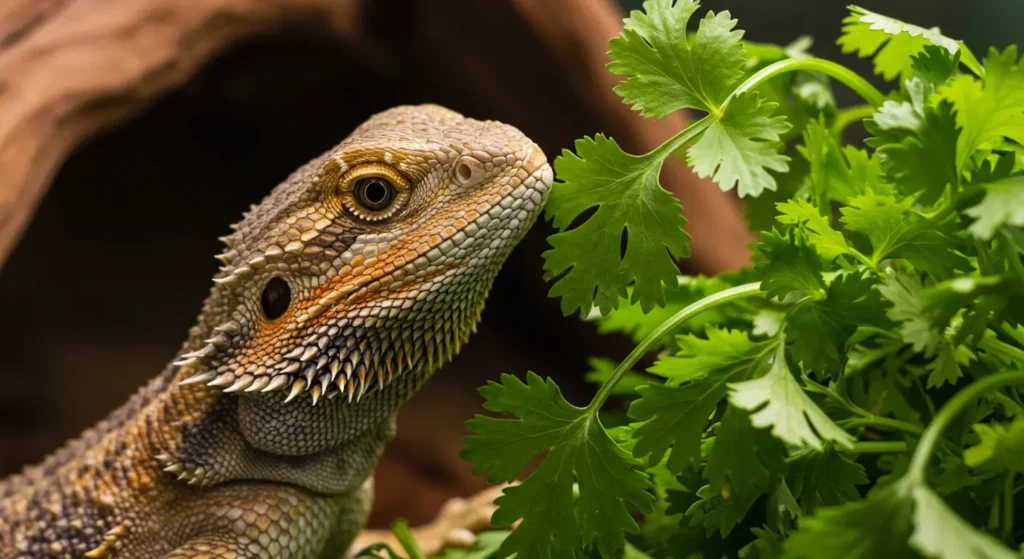
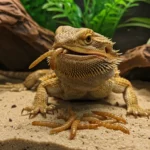
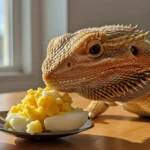
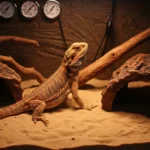

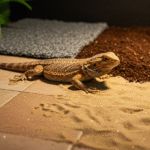
2 thoughts on “Can Bearded Dragons Eat Cilantro? The Truth”